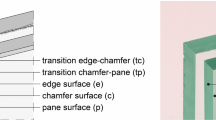The main reasons for the appearance of rejects during glass cutting are presented: off-cut breakage and breakage during cutting. Attention is focused mainly on the residual stresses in the glass; equipment-related reasons for rejects are briefly discussed. The existing method of monitoring the residual stresses in glass and its drawbacks are examined. These studies have made it possible to clarify the reasons for problems arising during glass cutting. Explanations are given for the results obtained.







Similar content being viewed by others
References
M. V. Swain, “Median crack initiation and propagation beneath a disc glass cutter,” Glass Technol., 22, No. 5, 222 (1981).
M. V. Swain, J. C. Metras, and C. G. Guillemet, “A deformation and fracture mechanics approach to the scoring and breaking of glass,” J. Non-Cryst. Solids, 38 – 39, No. 1, 447 (1981).
V. A. Litvinov, I. A. Maistrenko, E. A. Tarasov, and F. B. Grinberg, “Cutting glass with a hard-alloy roller,” Glass Ceram., 29(12), 793 – 795 (1972).
T. A. Insolio, “The cutting of glass,” Basic Requirements for Hand Cutting Glass, 7, 252, 254 (1981).
M. I. Smirnov, V. I. Motin, and A. G. Chesnokov, “Problems during cutting of sheet glass,” Steklo Biznes, No. 1 – 2 (2009).
M. I. Smirnov, Yu. A. Spiridonov, and A. R. Karapetyan, “Modern sheet-glass-cutting technologies,” Steklo Keram., No. 1, 6 – 10 (2011); M. I. Smirnov, Yu. A. Spiridonov, and A. R. Karapetyan, “Modern sheet-glass cutting technologies,” Glass Ceram., 68(1 – 2), 6 – 10 (2011).
N. M. Pavlushikin, Chemical Technology of Glass and Sitals [in Russian], Stroiizdat, Moscow (1983).
H. W. and R. I. McKenzie, “Hand Basic optical stress measurement in glass,” in: The Society of Glass Technology (1999), pp. 25 – 34.
GOST 3519. Optical Materials: Methods of Determining Birefringence [in Russian], Izd. Standartov, Moscow (1992).
GOST 111–2001. Sheet Glass: Technical Conditions [in Russian], Moscow (2001).
O. S. Narayanaswamy, “Stress generation and redistribution in annealing and cutting of glass ribbon,” in: 18th International Congress on Glass, San Francisco (1998).
Y. Bistrat and S. G. Roberts, “Residual stress measurement by Hertzian indentation,” Mater. Sci. Eng. A, 288, 148 – 153 (2000).
Author information
Authors and Affiliations
Corresponding author
Additional information
Translated from Steklo i Keramika, No. 5, pp. 11 – 15, May, 2012.
Rights and permissions
About this article
Cite this article
Sarkisov, P.D., Smirnov, M.I., Spiridonov, Y.A. et al. Effect of residual stresses in float-glass on cutting quality. Glass Ceram 69, 149–152 (2012). https://doi.org/10.1007/s10717-012-9434-0
Published:
Issue Date:
DOI: https://doi.org/10.1007/s10717-012-9434-0




